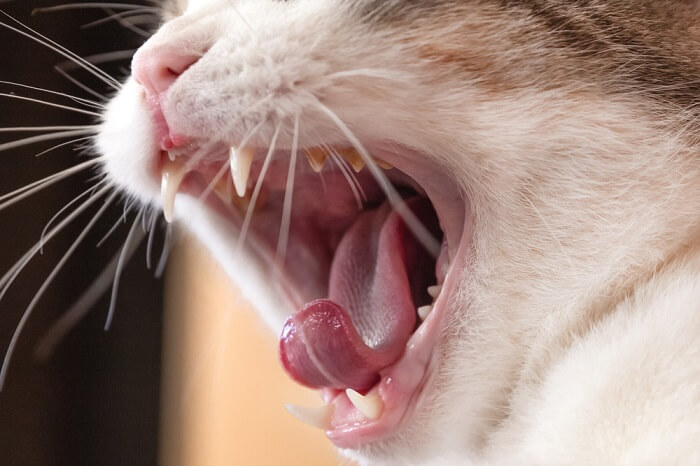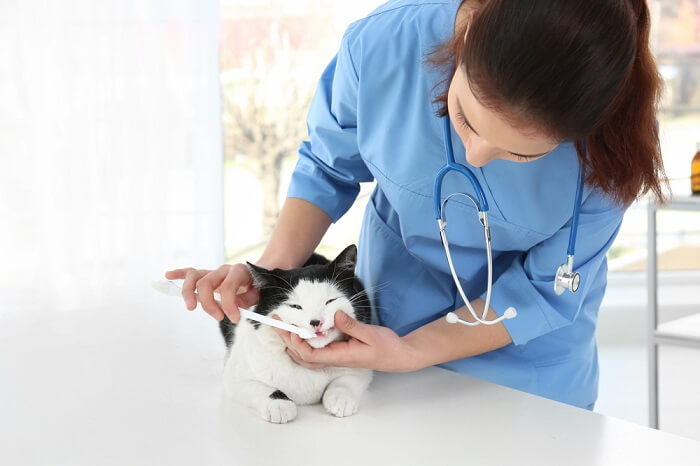
Although Oral tumors in cats are uncommon, they can have significant impacts on affected cats. Various types of oral tumors can afflict cats, each presenting distinctive clinical signs, treatment considerations, and prognoses. Much like other forms of cancer, timely detection enhances the array of treatment possibilities and improves overall outcomes. Early diagnosis is pivotal in offering more effective intervention options.
Causes
We don’t always know the cause of cancer, but there have been some predisposing factors identified in squamous cell carcinoma in cats. These include living in smoking households, chronic dental issues, such as periodontal disease, cats infected with FeLV (Feline Leukemia Virus) or FIV (Feline Immunodeficiency Virus) may be at a higher risk of developing oral tumors..
Cats will be exposed to smoke when it settles on their fur and they groom themselves. They are like the canary in the coal mine that shows us the harmful effects of smoking to us as well as our pets.
Clinical Signs of Oral Tumours in Cats
Like in humans, many of the clinical signs of oral cancer can mimic dental disease. Because of this, in both cats, dogs, and humans, oral cancer is often diagnosed during dental procedures.
Clinical signs of oral cancer in cats may include a mass or swelling in the jaw, loss of teeth, oral pain (inappetence, pawing at the jaw, head shy), difficulty picking up food, drooling, bad breath and discharge from the mouth.
If any of these clinical signs are noted, your cat should be evaluated by your veterinarian and, in a lot of cases, they should be scheduled for a dental procedure and/or oral biopsy. Oral tumours are most commonly diagnosed in geriatric cats.
Diagnosis
During a dental procedure, X-rays of the jaw may be taken to evaluate the teeth and the bone that is affected.
Tumours may cause abnormalities in the jaw bone, most often this looks like the bone has been eaten away by the tumour, but sometimes there is a proliferation of boney tissue as well.
Ultimately, a tissue biopsy is necessary to definitively diagnose an oral tumour. The most common oral tumour diagnosed in cats is squamous cell carcinoma. Early diagnosis is important because it allows for more treatment options and because oral cancer is painful, so the earlier it is addressed the better.
Treatment Planning
Once a diagnosis of oral cancer, likely squamous cell carcinoma, is made, the next step is staging tests to determine the extent of the cancer. If surgery or radiation is part of the treatment plan, this will usually involve a CT scan.
The CT will be used to evaluate the extent of the tumour itself, the local lymph nodes, and the lungs. Most commonly, this tumour is locally aggressive, meaning that it is an invasive tumour at the site where it starts.
In general, the metastatic rate is low, but this tumour can spread to the local lymph nodes and the lungs. The lymph nodes can be assessed by taking a sample of the cells with a needle and sending it to the lab for cytology and/or by removing them surgically.
Treatment Options

Treatment of oral tumours in cats is varied and depends on the extent of the cancer.
For patients with tumours of the upper (maxilla) or lower (mandible) jaw and no evidence of cancer spread, surgery is a potential treatment option. The CT scan will be used to assess if the tumour can be removed surgically.
The aggressive nature of the tumour combined with the small size of the jaw in cats can make surgical treatment challenging, especially if the diagnosis has been delayed. As a rule of thumb, the goal of surgery is to remove the tumour and bone with a margin of approximately 1cm around the tumour.
This means that a portion of the jaw bone and teeth are removed, which is called a maxillectomy or mandibulectomy. The CT is used to determine if surgery is feasible and plan the surgical approach. The goal of surgery is to remove all of the cancer that can be seen and felt and a margin of normal tissue around the tumour.
This “normal†tissue will contain microscopic invading cells around the tumour. The goal of surgery is to remove all of these microscopic cells along with the tumour so that no cancer cells are left behind.
Surgery should be performed by a veterinary surgeon with experience in oral cancer surgery.
Potential complications of surgery include:
- Bleeding
- Swelling
- Infection
- Incisional complications (which may require a revision surgery)
- Anorexia
- Incomplete margins of excision and tumour recurrence.
Before surgery, cats should have their blood type checked and the facility performing surgery should be prepared to administer a blood transfusion if needed.
The lack of desire or inability to eat after mandibulectomy or maxillectomy is uncommon in dogs but very common in cats. In most cases, an esophageal feeding tube is placed at the time of surgery. Cats must receive adequate nutrition and hydration to help them to heal after surgery.
Recovery
A period of anorexia in cats for any reason can also lead to secondary illnesses such as liver disease. The feeding tube also makes it easier to administer medications to these patients after surgery.
The ability and drive to eat after surgery varies with the patient and the extent of surgery, but cat owners should be prepared to take over both feeding and grooming for their cats for at least a month. There will be a small percentage of cats that will not go back to eating or grooming on their own and their owners will need to take care of this lifelong.
Most cats will be hospitalized for 1-3 nights after surgery for supportive care and pain control. The first week after surgery will require a lot of work on the owner’s part and these patients will require a lot of attention and nursing care.
The segment of the jaw and the draining lymph nodes that are removed will be sent to the lab for histopathology post-operatively. This is to confirm the diagnosis, but also to check if the margins or cut edges are clear of cancer cells.
If the margins and lymph nodes are clear of cancer cells, the long-term prognosis is excellent. Cats that have incomplete margins will often experience local recurrence and this disease will often be their life-limiting problem.
For cats that have tumours that involve the base of the tongue, tonsils, jaw masses deemed unresectable, cats with metastatic disease, or for owners that do not wish to pursue surgical treatment, radiation therapy may provide a more palliative option.
The radiation protocols will vary with the individual case, but often these cases are treated with coarse-fractionated radiation, meaning that they have 3-5 doses of radiation therapy. Unfortunately, the long-term prognosis with this approach is not favourable, with reported median survival times of approximately three months.
Palliative care is also an option for these cats, with a focus on pain control and quality of life. This may include nonsteroidal anti-inflammatory medications, opioids such as buprenorphine, antibiotics to manage any secondary infection, and canned palatable foods.
Quality of life should be monitored closely by cat owners. This can be monitoring weight, normal behaviours, and the desire or ability to eat. When the quality of life declines, these cats should be humanely euthanized.
Prevention and Early Detection

The most significant thing you can do to prevent squamous cell carcinoma in cats is to avoid exposing them to smoke. In oral cancers in cats and in general, cancers can be more successfully treated if they are detected early, so clinical signs or oral cancer should be acted on as soon as possible.
If clinical signs of oral disease progress after empirical treatments like antibiotics, dental cleaning or pain control, dental X-rays and a biopsy should be performed as soon as is possible.
Frequently Asked Questions
How long can a cat live with oral cancer?
This depends on the treatment. Without treatment, the median survival time is less than 3 months. With radiation therapy, the median survival time is around 3 months. With surgery and clean margins, these cats can live their natural life span.
What is the most common oral tumor in cats?
Squamous cell carcinoma.
Is oral cancer in cats painful?
Likely yes, as squamous cell carcinoma tends to invade bone.
What does a tumor in a cat's mouth look like?
This can look like a reddish mass, like dental disease or like a firm swelling. Any masses or swellings in the mouth of older cats should be investigated.
-
Boston SE, van Stee LL, Bacon NJ, Szentimrey D, Kirby BM, van Nimwegen S, Wavreille VA. Outcomes of eight cats with oral neoplasia treated with radical mandibulectomy. Vet Surg. 2020 Jan;49(1):222-232. doi: 10.1111/vsu.13341. Epub 2019 Nov 18. PMID: 31738456.
-
Gendler A, Lewis JR, Reetz J, Schwarz T. Computed tomographic features of oral squamous cell carcinoma in cats: 18 cases (2002-2008). J Am Vet Med Assoc. 2010;236:319-325.
-
Fulton AJ, Nemec A, Murphy BG, Kass PH, Verstraete FJ. Risk factors associated with survival in dogs with nontonsillar oral squamous cell carcinoma 31 cases (1990-2010). J Am Vet Med Assoc. 2013;243(5):696-702.
-
Hayes AM, Adams VJ, Scase TJ, Murphy S. Survival of 54 cats with oral squamous cell carcinoma in United Kingdom general practice. J Small Anim Pract. 2007;48(7):394-399.
-
Hutson CA, Willauer CC, Walder EJ, Stone JL, Klein MK. Treatment of mandibular squamous cell carcinoma in cats by use of mandibulectomy and radiotherapy: seven cases (1987-1989). J Am Vet Med Assoc. 1992;20:777-781.
-
Northrup NC, Selting KA, Rassnick KM, et al. Outcomes of cats with oral tumors treated with mandibulectomy: 42 cases. J Am Anim Hosp Assoc. 2006;42:350-360.
-
Poirier VJ, Kaser-Hotz B, Vail D, Straw RC. Efficacy and toxicity of an accelerated hypofractionated radiation therapy protocol in cats with oral squamous cell carcinoma. Vet Radiol Ultrasound. 2012;54:81-88.
-
Sabhlok A, Ayl R. Palliative radiation therapy outcomes for cats with oral squamous cell carcinoma (1999-2005). Vet Radiol Ultrasound. 2014;55:565-570.
-
Soltero-Rivera MM, Krick EL, Reiter AM. Prevalence of regional and distant metastasis in cats with advanced oral squamous cell carcinoma: 49 cases (2005-2011). J Feline Med Surg. 2013;16(2):164-169.








Any recommendations on treating a 6 month kitten with an odontoma benign tumor on mandible? Life expectancy without treatment? Prognosis with tumor removal and Mandibulectomy? How do kittens tolerate Mandibulectomy? Do they tend to recover or tolerate better than adult cats?
Hello Heidi! Apologies for the late reply. Frankly, that question is a bit out of my depth! I’d recommend sharing it with the Cats.com Community Health forum, where a veterinarian will be able to answer you. Hope this helps!